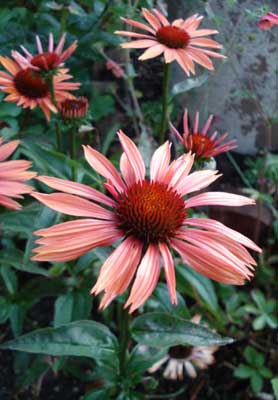
'Sundown'
aka 'Evan Saul'
Orange Coneflower
"The girls were busy with their flowers,
Whiling away the pleasant hours."
-from Esther (1865)
by Jane Elizabeth Holmes
by Jane Elizabeth Holmes
"Bumblebees come,
Hover, hesitate,
Drink, & are gone."
-Emily Dickinson
(1830-1886)
(1830-1886)
The pair of photos placed at the immediate right are portraits of blossoms on the same clump of 'Sundown' echinacea, photographed the same day.
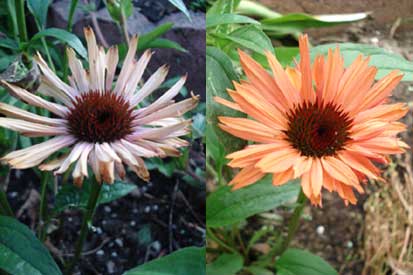 The color on the furthest-right is more typical, but throughout its flowering weeks it'll be a mite unpredictable. I was only surprised to see two of the blooms so very different in the same moment, rather than a couple weeks apart.
The color on the furthest-right is more typical, but throughout its flowering weeks it'll be a mite unpredictable. I was only surprised to see two of the blooms so very different in the same moment, rather than a couple weeks apart.That pair of photos is from their first flush of flowering, early in July. The first & third photos show the flowers in their more ideal color. The fourth photo shows the same cultivar as it looked late May & early July much more to the orange side than the purply-pink, & the last photo shows the orangish & the purple blooms on a single branching stem.
Obviously the color isn't all that stable, nor even the form, since it produces frilly overlapping petals, then a single row of non-overlapping petals, all on the same clump within a month's time.
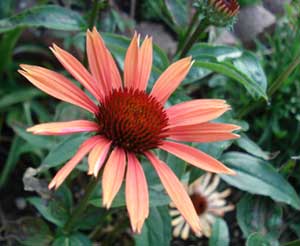 This clump will continue to flower right up to October. First frost often isn't enough to stop a happy echinacea, as which won't want to believe it's really all that cold.
This clump will continue to flower right up to October. First frost often isn't enough to stop a happy echinacea, as which won't want to believe it's really all that cold.'Sundown' (or 'Big Sky Sundown,' because the cultivar series was named 'Big Sky') is the second orange coneflower developed by ItSaul Plants. The first one was 'Sunset' (or 'Big Sky Sunset'), which has been discontinued in favor of 'Sundown,' & even 'Sundown' is bound eventually to be discarded in favor of an improved cultivar at some point, since it still needs a more stabilized color.
There are even dissatisfied gardener reports that 'Sundown' is an inferior plant its second year & really only exciting as "dressed" for market (typically over-fertilized). This hasn't been my experience at all, & when they fail, it's possibly the fault of assuming they're as drought-hardy as the species (they are not), or a problem of low pH soil, as several of these hybrid coneflowers get scruffy or even die if pH plummets.
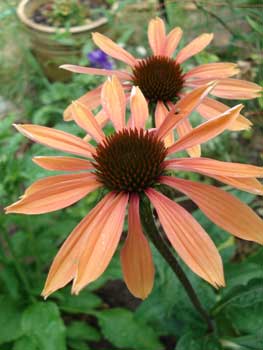 A light mulching of the echinacea beds, late in autumn, with well-composted chicken manure, or with leafmold, will keep the pH high. I've found 'Sundown' unusually hardy, but in the past I've tried to establish some of them in harsher gardens where the old standard 'Magnus' thrives, & soon realized you just can't push their hardiness very far.
A light mulching of the echinacea beds, late in autumn, with well-composted chicken manure, or with leafmold, will keep the pH high. I've found 'Sundown' unusually hardy, but in the past I've tried to establish some of them in harsher gardens where the old standard 'Magnus' thrives, & soon realized you just can't push their hardiness very far.'Sundown' & 'Sunset' not only have confusingly similar names, but they look rather alike, though 'Sundown' is on average a bit taller (but still compact at three feet or a mite more) with larger leaves, with flowers a bit smaller than 'Sunset.'
Of the two, I rather liked 'Sunset' a mite better (though who can help liking all the new-millenium echinaceas). However, 'Sundown' is more swiftly developed for market, so that 'Sunset' is being displaced, most growers discontinuing it.
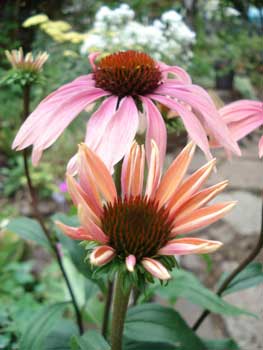 'Sundown' is a registered trademark name, & its actual registered cultivar name is 'Evan Saul,' after the son of Richard Saul of the Saul Brothers Nursery, Atlanta, Georgia.
'Sundown' is a registered trademark name, & its actual registered cultivar name is 'Evan Saul,' after the son of Richard Saul of the Saul Brothers Nursery, Atlanta, Georgia.Sundown/Evan Saul is a cross of E. purpurea with E. paradoxa. It was released in 2005 along with the pale yellow 'Sunrise' which is usually a little shorter with slightly larger flowers.
As 'Sundown' was only crossbred in 2002, & the best offspring chosen for tissue-culturing in 2003, it was truly rushed to market only three years after its invention, there having been no question at all of its inevitable public appeal.
Most echinaceas have reflexed petals but 'Sundown' blossoms have horizontal petals or only very slightly drooped. It is both floriferous & long-flowering. It blooms at least from July to October, sometimes longer, holding its excellent color throughout its long bloom time.
It is cold-hardy & heat hardy in zones five through eight, potentially stretchable to zones three & ten with protection at the extremes. It is not, however, quite as drought-hardy as "regular" echinacea & will want regular watering in long dry summers, though it can dry out briefly between waterings. Perfect drainage is a must, however, as echinaceas are nearly unkillable except when they often have wet feet.
Echinaceas are very appealing to bees & butterflies, suited to both the butterfly garden & the cutting garden. The ripened seedheads attract finches which will cling to a stem pecking seeds from autumn cones.
Continue to:
'Sunset' Echinacea